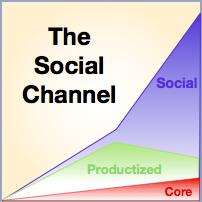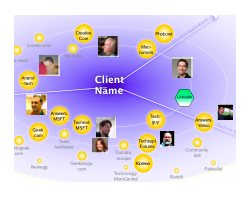 Branch disruption enables unusual opportunity for bank executives who consider transforming their relationships with clients. More generally, retail banking provides an excellent example of an Industrial Economy industry whose services are facing commoditization and weakening profits due to the waning of the Productized Channel of Value. In 2013, bank branch networks are under intense scrutiny because they are expensive, and client visits have been falling steadily for several years as e-banking and m-banking adoption have accelerated. Astute banks will use branches to transform their client relationships by leveraging the Social Channel. Here’s how they will do it. Continue reading Bank Branch Disruption Enables Unusual Opportunity [updated]
Branch disruption enables unusual opportunity for bank executives who consider transforming their relationships with clients. More generally, retail banking provides an excellent example of an Industrial Economy industry whose services are facing commoditization and weakening profits due to the waning of the Productized Channel of Value. In 2013, bank branch networks are under intense scrutiny because they are expensive, and client visits have been falling steadily for several years as e-banking and m-banking adoption have accelerated. Astute banks will use branches to transform their client relationships by leveraging the Social Channel. Here’s how they will do it. Continue reading Bank Branch Disruption Enables Unusual Opportunity [updated]
|
|||||
|
By Christopher Rollyson November 8th, 2012 | Tags: Adoption, Analysis, Bank, CEO, CMO, Collaboration, Community, Customer, Empowerment, Executive, Experience, Howto, Innovation, Knowledge Economy, LinkedIn, Mobile, Relationship, Social channel, Social network, Strategy, Transform, Trust | Category: Financial services, Social Business, Society & Culture | Leave a comment By Christopher Rollyson
Next Door’s main online presence is oriented toward free membership. Members can book space, sign up for classes and hold events. Here’s IDEO’s case study on the concept and design process. Continue reading Social Business in Insurance: State Farm’s Chicago Coworking Space November 7th, 2012 | Tags: Adoption, Case study, Collaboration, Community, Culture, Empowerment, Experience, Facebook, Innovation, Insurance, Knowledge Economy, Local, Marketing, Relationship, Social network, Strategy, Transform, Trust, Twitter | Category: Financial services, Society & Culture | 2 comments By Christopher Rollyson
By conducting external and internal due diligence, we arrive at a social business strategy that optimizes the what the ecosystem values most highly with the firm’s ability to deliver. The social business strategy marries the ecosystem audit with the organization audit to determine optimal sharing scenarios (pilots). The social business Organization Audit begins with a basic core competency analysis, drills down to stakeholder issues & actions and synthesizes these steps into several “trial pilots” that it will then vet through several other steps: social business good practices uses the ecosystem as a filter to learn from other firms’ similar initiatives, resource analysis gauges employees’ knowledge, experience and skills, and organization analysis uncovers organizational strengths and weaknesses that could affect pilots. October 31st, 2012 | Tags: Adoption, CMO, Development, Enterprise, Enterprise 2.0, Howto, Human capital, Innovation, Management, Strategy, Technique, Tools | Category: Social Business | 21 comments By Christopher Rollyson
October 24th, 2012 | Tags: Adoption, Advice, Collaboration, Development, Empowerment, Enterprise, Enterprise 2.0, Executive, Innovation, Management, Strategy, Technique, Transform | Category: Social Business | 15 comments By Christopher Rollyson How to Outperform by Managing the Social Business Risks that Slow Your Competitors
October 23rd, 2012 | Tags: Adoption, CMO, Enterprise, Enterprise 2.0, Management, Marketing, Social network, Strategy, Technique, Transform | Category: Social Business | 2 comments By Christopher Rollyson
What does this mean for branches? I’ll offer a surprising alternative. Continue reading Reflecting on the Size and Value of Bank Branch Networks October 9th, 2012 | Tags: Adoption, Analysis, Bank, Big data, Experience, Innovation, Mobile, Relationship, Social network, Transform | Category: Economy, Financial services | Leave a comment By Christopher Rollyson
The point remains, imagination and inertia are preventing financial services firms from engaging with clients and prospects in digital social venues, not regulators. Here’s how it’s done. Continue reading Financial Services Social Business Pioneer: Putnam Investments October 2nd, 2012 | Tags: Adoption, Advice, Case study, CEO, CMO, Executive, Innovation, LinkedIn, Management, Marketing, Platform, Strategy, Transform | Category: Blogs, Financial services, Twitter | Leave a comment By Christopher Rollyson
Since the Social Channel is so important, I have published the Social Channel Trilogy, which is summarized here. Find even more information on the Social Channel home page. Continue reading The Social Channel of Value [Executive Summary] September 27th, 2012 | Tags: Adoption, Advice, CEO, CIO CTO, CMO, Culture, Enterprise, Executive, Experience, Globalization, Howto, Human capital, Innovation, Knowledge Economy, Management, Marketing, Relationship, Social channel, Strategy, Technique, Transform, Trust | Category: Economy, Emerging Markets, Market drivers, Social Business, Society & Culture | 11 comments By Christopher Rollyson
September 26th, 2012 | Tags: Adoption, Advice, Collaboration, Community, Culture, Empowerment, Enterprise, Enterprise 2.0, Howto, Human capital, Management, policy, Relationship, Social network, Technique, Trust | Category: Human resources, Social Business | 4 comments By Christopher Rollyson
Here I’ll offer my insights into client outcomes as well as how we’ve evolved the process and why. You will get some practical pointers about how you can do your own. Continue reading The Digital Social Ecosystem Audit The Key to Optimal Interactions September 22nd, 2012 | Tags: Advice, Analysis, Howto, Internet, Management, ROI, Technique | Category: Social Business | 27 comments |
ThemesTopicsAdoption
Advice
Analysis
Career
Case study
CEO
CIO CTO
CMO
Collaboration
Community
Conference
Culture
Customer
Development
Economics
Employee
Empowerment
Enterprise
Enterprise 2.0
Executive
Experience
Facebook
Globalization
Government
Higher education
Howto
Human capital
Innovation
Internet
Knowledge Economy
LinkedIn
Management
Marketing
Mobile
News
Politics
Reflection
Relationship
Social network
Strategy
Technique
Technology
Transform
Trust
Twitter
Past Issues |
||||
|
Copyright © 2025 Christopher S. Rollyson and Associates - All Rights Reserved Powered by WordPress & Atahualpa |
|||||






